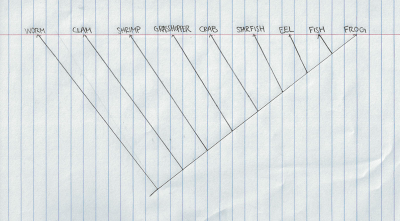Summary
This article talks about the discovery of fossils of Anomalocaris, a Cambrian segmented
invertebrate. It primarily concentrates on the shape of their bodies based on
fossil evidence, which would impact the assumptions on the creature. The
article presents the different hypotheses that paleontologists had on the
structure of Anomalocaris. It begins
by introducing paleontologist Charles Walcott’s idea that it was an archaic
form of a jellyfish. However, the discovery of their mouth structures gave
evidence that Anomalocaris was a
predator that fed on hard-shelled trilobite. This was, again, contradicted by
evidence that claimed Anomalocaris
didn’t feed on hard-shelled trilobites due to their mouth shapes. It is then
presented that the Anomalocaris probably
fed on small prey in the mud by sucking them up instead of chomping on them.
Fossils used to determine age of organism
The age of a fossil can determine the age of the organism
and seeing which layer of rock it is found in can identify the fossil’s age.
The older the fossil, the deeper it would be located in the layers. According
to the article, scientists found out the age of the Anomalocaris fossil by identifying other fossils found nearby in
the same site (Burgess Shale Site.) The article reveals that the fossils were
505 million years old.
Morphology providing evidence for common ancestry
Anomalocaris was
such a strange creature to the point where scientists assumed the parts that
made up the creature were from different creatures and it was only recently
that scientists found out what it looked like. The creature is described to
have stalked eyes, swim flaps, spiked grasping appendages, and plated mouths
making it look alien-like. When scientists assumed it was an archaic jellyfish,
this was primarily due to a flattened ring that was identified on the fossil,
which were the squishy discs on the mouth of the Anomalocaris. This misconception, however, was replaced with the
discovery of its different body parts that made it become categorized with
arthropods in the fossils. This is due to Anomalocaris’s
segmented body that its swim flaps extend out from. This means that current
arthropods such as shrimps have a high chance that they evolved from Anomalocaris.
| http://www.wired.com/images_blogs/wiredscience/2011/05/Image-1-Laggania-660x440.jpg |
What it is
The four major evolutionary developments start with the
development of three tissue layers, continuing with the development of, in
order, bilateral symmetry, internal cavity, and type of zygote cleavage. The
three tissue layers that are developed in triploblastic creatures such as
arthropods are the ectoderm, endoderm, and mesoderm. However, tissues were
never brought up in the article so there is no way to determine if Anomalocaris are animals through this
development. Despite this, we can see from the picture above that Anomalocaris is an animal because it has
a bilateral symmetry. Each half of Anomalocaris
has an eye, a spikey appendage, and swim flaps. Thus, this gives support to
the argument that Anomalocaris are
animals. It is implied in the article that Anomalocaris
have internal cavities simply because it discusses about the mouth of the
creature and what it probably fed on (hard-shelled trilobites or scraps on the
ocean floor such as worms.) This means that Anomalocaris
is either a pseudocoelomate or a coelomate. Psuedocoelomates and coelomates
have body cavities unlike acoelomates but psuedocoelomates develop their body
cavities between the endoderm and mesoderm whereas coelomates develop their
coeloms in the mesoderm. According to the article, it is not mentioned whether
the Anomalocaris is a psuedocoelomate
or a coelomate. It is known that the type of zygote cleavage developed
primarily applies to coelomates in which they can be divided into two groups of
protostomes and deuterostomes. In protostomes, the zygote divides into two
cells, which keep dividing and end up forming the blastula. The blastopore,
which is the region where initial opening occurs during the early stages of
embryonic development, forms to become the mouth in protostomes. While in
deuterostomes, the blastopore becomes the anus first. The article, however,
does not discuss anything related to the type of zygote cleavage that Anomalocaris could have possibly
developed. Based on this evidence alone, we can identify that the Anomalocaris was an animal that had
bi-laterally symmetrical bodies and, in addition, was either a pseudocoelomate
or coelomate.
What it isn’t
It is not radially symmetrical because if it was sliced in
several different ways, there wouldn’t be any matching sections. It is also not
an acoelomate because they although they are bilaterally symmetrical like
acoelomates, they have body cavities. Therefore we can rule out all claims that
it was either Ctenophoras, Cnidarias, Poriferas, or Choanoflagellates as these
are all organisms that do not have bilateral symmetrical bodies. Anomalocaris also are not
Platyhelminthes or Acoelomorphas because these are organisms that do not have
body cavities.
What is not preserved in a fossil sample
Tissue is not preserved in fossil samples because it does
not preserve well, especially compared to bones. Therefore, it is hard for
scientists to determine a creature’s tissue sample based on fossil evidence.
This is probably why the article did not discuss issues such as whether Anomalocaris were pseudocoelomate or
coelomates, which in turn would make it hard to determine whether it was a
protostome or deuterostome. These facts can only be hypothesized based on evidence
from modern world descendants of the Anomalocaris
such as shrimps.
Source: http://www.wired.com/wiredscience/2012/05/cambrian-shutter-of-doom-becomes-sucker-of-worms/













